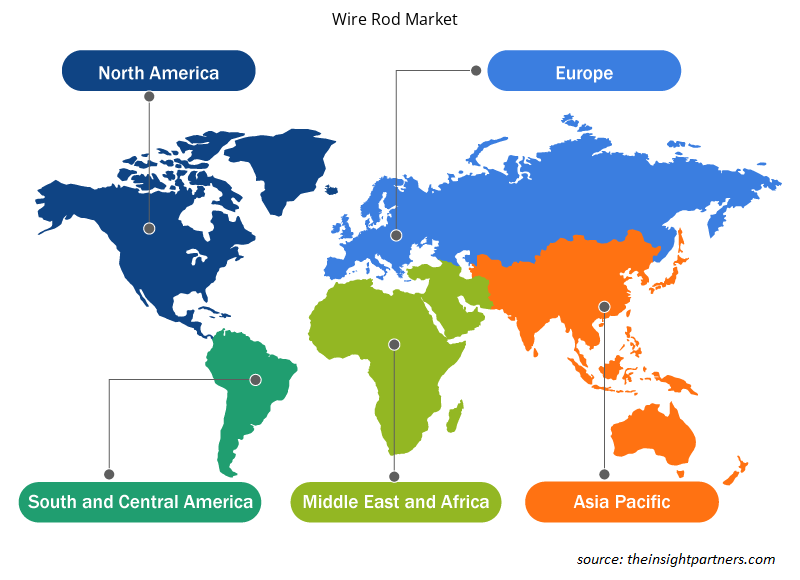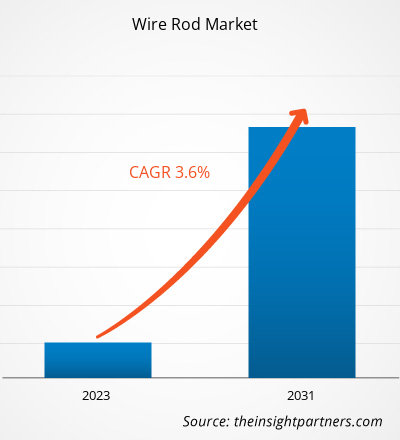线材市场规模预计将从 2023 年的 16.7814 亿美元增至 2031 年的 22.2504 亿美元。预计 2023-2031 年市场复合年增长率为 3.6%。
线材是通过将热金属拉过轴杆而制成的。这些轴杆从各个方向对金属进行成型和压缩,从而将一块金属变成细长的线材。它们具有圆形横截面并卷成线圈。它们是高压电缆和电线制造的优质原材料。这些线材用于承载负载、电力和电信信号。它们用于各种领域,包括电气、基础设施、航空、电信和汽车。例如,线材用于多种电子元件、电信电缆、插座和接线端子。
线材市场分析
世界各地的商业、工业和住宅建筑项目都在增长,主要集中在中国、印度、马来西亚、波兰、沙特阿拉伯和阿联酋等发展中国家。这一因素预计将推动各种电气和电子应用中对电线、钢丝绳、电线和电缆等产品的需求。因此,随着建筑活动的增加,使用不同线材的范围将持续扩大。例如,2023 年 2 月,Vedanta Aluminium 在 2023 年国际铝业大会 (IAC) 上推出了用于电气行业的 12 毫米铝线材
线材市场概况
线材是一种由矩形或圆柱形钢材制成的轧制钢产品。线材被卷成卷并运输成线材。这些线材广泛用于制造焊丝、电极、电缆、加固线和纤维。线材用途广泛,包括绑线、网、围栏、购物车、货架、线架和钉子。此外,从线材中拉出的线材经过涂漆、镀锌和电镀。
定制此报告以满足您的需求
您可以免费定制任何报告,包括本报告的部分内容、国家级分析、Excel 数据包,以及为初创企业和大学提供优惠和折扣
- 获取此报告的关键市场趋势。这个免费样品将包括数据分析,从市场趋势到估计和预测。
线材市场驱动因素和机遇
增加建筑和基础设施开发活动
线材采用连铸技术生产。包括电气工业在内的工业厂房建设的增加将推动线材的应用范围。据俄罗斯通讯社塔斯社报道,2021 年前五个月,俄罗斯的住房投入使用量与 2020 年相比增长了 28.4%。根据 Ridgewater Homes 网站的数据,2021 年澳大利亚住宅建筑建设增长了 10%。这一增长归因于持续的就业、创纪录的低利率以及 HomeBuilder 等政府计划的激增导致的住房需求增加。HomeBuilder 是澳大利亚政府的一项举措,旨在帮助住宅建筑行业买家增强信心,以进行采购或装修,这些采购或装修可能会因疫情造成的不确定性而被推迟。
此外,政府还采取多项举措支持住房行业的发展。例如,据韩联社网站报道,2021 年 2 月,韩国政府宣布将放宽建筑法规,支持全国范围内 836,000 套新房的建设,以支持该国城市地区的重建项目。此外,政府的新住房政策侧重于增加首尔大都市区和其他主要城市的房屋数量。
电力传输和配电投资不断增长
全球范围内城市化和数字化的不断发展,对不间断电力供应的需求不断增加。为此,全球对升级或安装新的电力传输和配电系统的需求正在增加。随后,各国政府增加了对电力和能源领域的投资。例如,2022 年 11 月,美国能源部 (DOE) 宣布投资 130 亿美元支持美国电网的升级和扩建。美国政府将根据电网弹性创新伙伴关系 (GRIP) 计划、输电促进计划和拜登总统的两党基础设施法提供这笔资金。通过这笔资金,美国政府旨在通过建设变革性项目来提高电网的可靠性。2022 年 11 月,英国能源监管机构 Ofgem 宣布了一项为期五年(2023 年至 2028 年)的投资计划,为配电网络公司提供约 266 亿美元的投资。这项投资旨在帮助提供更便宜、更清洁的能源,并提高当地电网的可靠性,同时不给消费者带来额外成本。
电动汽车普及率不断上升
线材是用于各种电动汽车部件(如电机、车载充电器、电池和电力控制单元 (EPCU))的重要部件。对零排放汽车的需求不断增长,以及通过补贴和退税等方式对零排放汽车的支持性法规不断增加,迫使制造商在全球范围内提供电动汽车。当转向电动汽车 (EV) 时,客户期望高水平的自动化体验和先进的驾驶功能。因此,电动汽车技术创新的不断增长将增加对线材的需求。
根据《全球电动汽车展望》,2021 年电动汽车(包括全电动和插电式混合动力汽车)的销量创下 660 万辆的新纪录。根据同一报告,在中国,2021 年电动汽车销量大幅增长至 330 万辆,约占全球总销量的一半。欧洲电动汽车销量强劲增长 65%,达到 230 万辆,美国 2021 年的销量比上一年翻了一番,达到 63 万辆。政府对电动汽车充电站的支持性法规推动了电动汽车的销售。2022 年 6 月,美国政府为其到 2030 年建设 50 万个电动汽车充电站全国网络的计划提出了新标准。此外,政府还推出了一项计划,到 2028 年向各州拨款 50 亿美元资助电动汽车充电器。因此,电动汽车销量的增长预计将在未来几年推动线材市场的发展。
线材市场报告细分分析
有助于得出线材市场分析的关键部分是材料和行业。
- 根据材料,市场分为铜、铝和其他。铜线棒具有高导电性和可成形性,是挤压应用的理想选择。凭借铜线棒带来的好处,铜线用于开关设备、变压器和许多其他电气应用。此外,随着对垫圈、手电筒、手工艺品、端子、金属拉链、金属成型、连接器、灯头、电子元件、电气配件、五金、电信、家用电器、管道产品、弹簧、锁和汽车散热器等产品的需求不断增加,铜线棒的使用范围将持续推动该领域的增长。
- 根据行业,线材市场分为电信、电力、航空、汽车等。由于 5G 技术的日益普及,电信行业在 2022 年的份额最大。
线材市场份额按地区分析
线材市场报告的地理范围主要分为五个区域:北美、亚太、欧洲、中东和非洲、南美/南美和中美。
北美的线材市场分为美国、加拿大和墨西哥。该地区市场的增长归因于汽车应用对线材的需求不断增长。根据美国汽车政策委员会 (AAPC) 的数据,美国汽车行业约占该国 GDP 的 3%。线材,尤其是铝线材,用于汽车制造过程中的精密零件。由于它们重量轻但耐用,因此在制造不同车辆(例如轿车和卡车)时对这些线材的需求日益增加。此外,铜线材还用于制造高效绕线电动机。
预计到 2023 年,亚太地区将占据最大份额。这是由于全球铜产量不断增加。根据世界金属统计局的数据,2021 年,日本生产了约 152 万公吨精炼铜。在总铜产量中,由于汽车、电子和电信行业的铜使用量不断增加,因此估计约有 60% 用于生产铜线材。此外,根据日本铝业协会的数据,2021 年,铝产量约为 786.6 万公吨。
线材市场区域洞察
Insight Partners 的分析师已详细解释了预测期内影响线材市场的区域趋势和因素。本节还讨论了北美、欧洲、亚太地区、中东和非洲以及南美和中美洲的线材市场细分和地理位置。

- 获取线材市场的区域特定数据
线材市场报告范围
| 报告属性 | 细节 |
|---|---|
| 2023 年的市场规模 | 16.7814亿美元 |
| 2031 年市场规模 | 22.2504亿美元 |
| 全球复合年增长率(2023 - 2031) | 3.6% |
| 史料 | 2021-2022 |
| 预测期 | 2023-2031 |
| 涵盖的领域 | 按材质
|
| 覆盖地区和国家 | 北美
|
| 市场领导者和主要公司简介 |
|
线材市场参与者密度:了解其对业务动态的影响
线材市场正在快速增长,这得益于终端用户需求的不断增长,而这些需求又源于消费者偏好的不断变化、技术进步以及对产品优势的认识不断提高等因素。随着需求的增加,企业正在扩大其产品范围,进行创新以满足消费者的需求,并利用新兴趋势,从而进一步推动市场增长。
市场参与者密度是指在特定市场或行业内运营的企业或公司的分布情况。它表明在给定市场空间中,相对于其规模或总市场价值,有多少竞争对手(市场参与者)存在。
在线材市场运营的主要公司有:
- 三菱综合材料贸易公司
- APAR工业有限公司
- 印度铝业工业有限公司
- 挪威海德鲁公司
- Leebo Metals 私人有限公司
- 住友电气工业株式会社
免责声明:上面列出的公司没有按照任何特定顺序排列。

- 获取线材市场顶级关键参与者的概述
线材市场新闻及最新发展
通过收集一手和二手研究后的定性和定量数据来评估线材市场,其中包括重要的公司出版物、协会数据和数据库。以下是市场创新、业务扩展和战略发展情况的列表:
- 2023 年 2 月,韦丹塔铝业公司在 2023 年国际铝业大会上推出了用于电气行业的 12 毫米铝线材。该公司的生产能力超过 560 千吨,并配备了生产线材的最先进技术。(来源:Eurofins,新闻稿)
- 线材市场报告覆盖范围及交付成果
- 《线材市场规模及预测(2021-2031年)》报告对市场进行了详细分析,涵盖以下领域:
- 线材市场规模及全球、区域和国家层面所有主要细分市场的预测
- 市场动态,如驱动因素、限制因素和关键机遇
- 线材市场趋势
- 详细的PEST分析和SWOT分析
- 线材市场分析涵盖主要市场趋势、全球和区域框架、主要参与者、法规和最新的市场发展。
- 线材市场行业格局和竞争分析,涵盖市场集中度、热图分析、知名参与者和最新发展。
- 详细公司简介
- 历史分析(2 年)、基准年、预测(7 年)及复合年增长率
- PEST 和 SWOT 分析
- 市场规模价值/数量 - 全球、区域、国家
- 行业和竞争格局
- Excel 数据集



Report Coverage
Revenue forecast, Company Analysis, Industry landscape, Growth factors, and Trends

Segment Covered
This text is related
to segments covered.

Regional Scope
North America, Europe, Asia Pacific, Middle East & Africa, South & Central America

Country Scope
This text is related
to country scope.
常见问题
Asia Pacific is expected to dominate the wire rod market in 2023.
Increasing construction and infrastructure development activities across the globe drive the wire rod market growth during the forecast period.
Rising Adoption of Electric Vehicles across the globe is driving the market growth.
Mitsubishi Materials Trading Corp, APAR Industries Ltd, Hindalco Industries Ltd, Norsk Hydro ASA, Leebo Metals Pvt Ltd, Sumitomo Electric Industries Ltd, Vedanta Aluminium and Power Ltd, United Co RUSAL Plc and Vimetco NV.
Wire rod market size is projected to reach US$ 2,225.04 million by 2031 from US$ 1,678.14 million in 2023.
The market is expected to register a CAGR of 3.6% in 2023–2031.
Trends and growth analysis reports related to Manufacturing and Construction : READ MORE..
The Insight Partners performs research in 4 major stages: Data Collection & Secondary Research, Primary Research, Data Analysis and Data Triangulation & Final Review.
- Data Collection and Secondary Research:
As a market research and consulting firm operating from a decade, we have published and advised several client across the globe. First step for any study will start with an assessment of currently available data and insights from existing reports. Further, historical and current market information is collected from Investor Presentations, Annual Reports, SEC Filings, etc., and other information related to company’s performance and market positioning are gathered from Paid Databases (Factiva, Hoovers, and Reuters) and various other publications available in public domain.
Several associations trade associates, technical forums, institutes, societies and organization are accessed to gain technical as well as market related insights through their publications such as research papers, blogs and press releases related to the studies are referred to get cues about the market. Further, white papers, journals, magazines, and other news articles published in last 3 years are scrutinized and analyzed to understand the current market trends.
- Primary Research:
The primarily interview analysis comprise of data obtained from industry participants interview and answers to survey questions gathered by in-house primary team.
For primary research, interviews are conducted with industry experts/CEOs/Marketing Managers/VPs/Subject Matter Experts from both demand and supply side to get a 360-degree view of the market. The primary team conducts several interviews based on the complexity of the markets to understand the various market trends and dynamics which makes research more credible and precise.
A typical research interview fulfils the following functions:
- Provides first-hand information on the market size, market trends, growth trends, competitive landscape, and outlook
- Validates and strengthens in-house secondary research findings
- Develops the analysis team’s expertise and market understanding
Primary research involves email interactions and telephone interviews for each market, category, segment, and sub-segment across geographies. The participants who typically take part in such a process include, but are not limited to:
- Industry participants: VPs, business development managers, market intelligence managers and national sales managers
- Outside experts: Valuation experts, research analysts and key opinion leaders specializing in the electronics and semiconductor industry.
Below is the breakup of our primary respondents by company, designation, and region:

Once we receive the confirmation from primary research sources or primary respondents, we finalize the base year market estimation and forecast the data as per the macroeconomic and microeconomic factors assessed during data collection.
- Data Analysis:
Once data is validated through both secondary as well as primary respondents, we finalize the market estimations by hypothesis formulation and factor analysis at regional and country level.
- Macro-Economic Factor Analysis:
We analyse macroeconomic indicators such the gross domestic product (GDP), increase in the demand for goods and services across industries, technological advancement, regional economic growth, governmental policies, the influence of COVID-19, PEST analysis, and other aspects. This analysis aids in setting benchmarks for various nations/regions and approximating market splits. Additionally, the general trend of the aforementioned components aid in determining the market's development possibilities.
- Country Level Data:
Various factors that are especially aligned to the country are taken into account to determine the market size for a certain area and country, including the presence of vendors, such as headquarters and offices, the country's GDP, demand patterns, and industry growth. To comprehend the market dynamics for the nation, a number of growth variables, inhibitors, application areas, and current market trends are researched. The aforementioned elements aid in determining the country's overall market's growth potential.
- Company Profile:
The “Table of Contents” is formulated by listing and analyzing more than 25 - 30 companies operating in the market ecosystem across geographies. However, we profile only 10 companies as a standard practice in our syndicate reports. These 10 companies comprise leading, emerging, and regional players. Nonetheless, our analysis is not restricted to the 10 listed companies, we also analyze other companies present in the market to develop a holistic view and understand the prevailing trends. The “Company Profiles” section in the report covers key facts, business description, products & services, financial information, SWOT analysis, and key developments. The financial information presented is extracted from the annual reports and official documents of the publicly listed companies. Upon collecting the information for the sections of respective companies, we verify them via various primary sources and then compile the data in respective company profiles. The company level information helps us in deriving the base number as well as in forecasting the market size.
- Developing Base Number:
Aggregation of sales statistics (2020-2022) and macro-economic factor, and other secondary and primary research insights are utilized to arrive at base number and related market shares for 2022. The data gaps are identified in this step and relevant market data is analyzed, collected from paid primary interviews or databases. On finalizing the base year market size, forecasts are developed on the basis of macro-economic, industry and market growth factors and company level analysis.
- Data Triangulation and Final Review:
The market findings and base year market size calculations are validated from supply as well as demand side. Demand side validations are based on macro-economic factor analysis and benchmarks for respective regions and countries. In case of supply side validations, revenues of major companies are estimated (in case not available) based on industry benchmark, approximate number of employees, product portfolio, and primary interviews revenues are gathered. Further revenue from target product/service segment is assessed to avoid overshooting of market statistics. In case of heavy deviations between supply and demand side values, all thes steps are repeated to achieve synchronization.
We follow an iterative model, wherein we share our research findings with Subject Matter Experts (SME’s) and Key Opinion Leaders (KOLs) until consensus view of the market is not formulated – this model negates any drastic deviation in the opinions of experts. Only validated and universally acceptable research findings are quoted in our reports.
We have important check points that we use to validate our research findings – which we call – data triangulation, where we validate the information, we generate from secondary sources with primary interviews and then we re-validate with our internal data bases and Subject matter experts. This comprehensive model enables us to deliver high quality, reliable data in shortest possible time.


 获取此报告的免费样本
获取此报告的免费样本